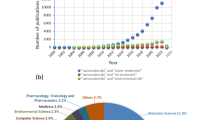
Overview
- Includes a detailed description of the biotransformation of nanomaterials in soil and plants
- In depth explanation of therapeutic applications of inorganic nanomaterials
- Nanomaterials modifications by several engineering processes have been explored
Part of the book series: Environmental Chemistry for a Sustainable World (ECSW, volume 27)
Access this book
Tax calculation will be finalised at checkout
Other ways to access
About this book
This third volume on environmental nanotechnology includes chapters dealing with topics such nanoremediation, waste water purification, nanosensors, nanomedicine, and nanofiltration. It also highlights the safety aspects and risk assessment and management related to several toxins, as well as nanotechnology related solutions for these challenges. The book also discusses new nanomaterials from the nexus of environment, water, remediation and total environment.
Similar content being viewed by others
Keywords
Table of contents (10 chapters)
-
Front Matter
-
Back Matter
Editors and Affiliations
About the editors
Dr. Nandita Dasgupta has vast working experience in nanoscience and is working as Assistant Professor at Department of Biotechnology, Institute of Engineering and Technology, Lucknow, India. She has worked on Mesenchymal stem cell derived exosomes for the treatment of uveitis. She has successfully engineered micro-vehicles for model drug molecules. Her areas of interest include nanomaterial fabrication and its applications in medicine, food, environment, agriculture and biomedical.She is the associate editor of Environmental Chemistry Letters. She has received several awards and recognitions from different national and international organizations.
Dr. Shivendu Ranjan is scientist at the DST-Centre for Policy Research, Lucknow, India. He is also serving as a senior research associate, adjunct, at the Faculty of Engineering and Built Environment, University of Johannesburg, South Africa. His research interests include nanotechnology, nanomedicine, science policy and diplomacy.He is associate editor of Environmental Chemistry Letters and editorial board member of Biotechnology and Biotechnological Equipment. He has received 20 awards and honors.
Dr. Eric Lichtfouse is an environmental chemist working at the University of Aix-Marseille, France. He has invented carbon-13 dating. He is teaching scientific writing and communication, and has published the book Scientific Writing for Impact Factors. He is founder and Chief Editor of scientific journals and series in environmental chemistry and agriculture. He got the Analytical Chemistry Prize from the French Chemical Society, the Grand Prize of the Universities of Nancy and Metz, and a Journal Citation Award by the Essential Indicators.
Bibliographic Information
Book Title: Environmental Nanotechnology Volume 3
Editors: Nandita Dasgupta, Shivendu Ranjan, Eric Lichtfouse
Series Title: Environmental Chemistry for a Sustainable World
DOI: https://doi.org/10.1007/978-3-030-26672-1
Publisher: Springer Cham
eBook Packages: Earth and Environmental Science, Earth and Environmental Science (R0)
Copyright Information: Springer Nature Switzerland AG 2020
Hardcover ISBN: 978-3-030-26671-4Published: 28 November 2019
Softcover ISBN: 978-3-030-26674-5Published: 28 November 2020
eBook ISBN: 978-3-030-26672-1Published: 18 November 2019
Series ISSN: 2213-7114
Series E-ISSN: 2213-7122
Edition Number: 1
Number of Pages: XV, 362
Number of Illustrations: 16 b/w illustrations, 44 illustrations in colour
Topics: Waste Water Technology / Water Pollution Control / Water Management / Aquatic Pollution, Nanotechnology, Agriculture, Atmospheric Protection/Air Quality Control/Air Pollution, Environmental Chemistry



